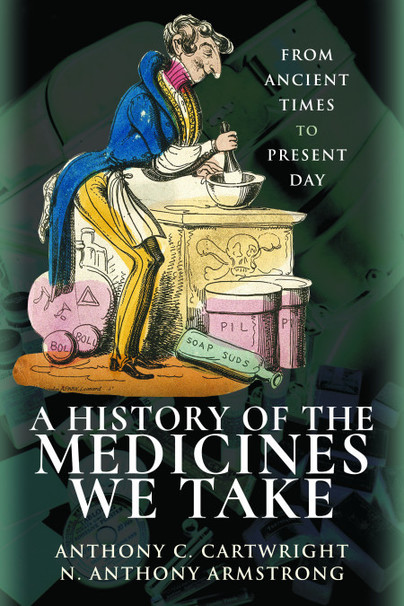Author Guest Post: Anthony C. Cartwright
Tony Cartwright’s new book was published during lockdown
Many things were delayed or changed during the lockdown due to the Covid-19 pandemic. Amongst them authors found that publication of their new books was either delayed, or, that if not delayed, were dismayed to find that the bookshops were shut when their books launched. My new paperback book ‘A History of the Medicines We Take’ was published by Pen and Sword in May. It is an account of the history of the development of medicines from traces of herbs found with the remains of Neanderthal man to pure drugs extracted from plants in the nineteenth century to the latest biotechnology antibody products. The second part of the book tells the story of the development of the preparations that patients take and their inventors, such as Christopher Wren who gave the first intravenous injection in 1656 and William Brockedon who invented the tablet in 1843.
Although the book was researched and written before the current pandemic, some themes in the book are very relevant to today. We are all anxiously waiting for the availability of a vaccine against Covid-19, and over 200 separate vaccines are now in development. Amongst those likely to have priority for vaccination are older adults in care homes, care home staff, people over 80 and health and social care workers. The book describes the development of vaccines from the first smallpox vaccine treatments using cowpox by Devon farmer Benjamin Jesty in 1774 (over twenty years before Edward Jenner’s experiments).
Another theme in the book is ‘repurposing’ of existing drugs. It takes from 12-15 years to develop and get approval for a new drug, and it costs up $2 billion. It makes sense to look at old drugs to see if they can be used for a new indication, as they can then be clinically tested in patients and approved much more quickly and cheaply. The Gilead antiviral drug remdesivir, used to treat President Trump for his Covid-19 infection, was originally developed in 2009 to treat hepatitis C, and then investigated against Ebola virus. It has now been found to cut the length of illness in hospitalised patients with Covid-19. It has been approved in the UK and available in the NHS for use in selected patients Another old drug now used to treat Covid patients in hospital who need supplemental oxygen is the steroid dexamethasone. This drug has been used to treat many conditions since it was first marketed in 1961. It was tested in the UK RECOVERY trial, one of the largest trials of potential Covid-19 treatments, and was found to reduce deaths in patients.
The book describes the first development of monoclonal antibodies in 1975 by the Nobel prize winners Cesar Milstein and George Kohler. Many monoclonal antibody products are now approved for a variety of conditions including arthritis, organ rejection, leukaemia, melanoma, breast cancer and multiple sclerosis. A number of pharmaceutical companies are developing and testing these products to treat Covid-19. REGN-COV2 is a combination of two experimental monoclonal antibody products produced by the US company Regeneron. It was used to treat President Trump’s Covid infection. The combination targets two different sites of the spike protein found on the surface of the Covid-19 virus. Researchers at the University of Texas Health Science Center at Houston have launched a trial of this combination antibody treatment for preventing Covid-19 illness in individuals who have had sustained exposure to someone with the virus, such as a household contact. It is now being evaluated in the UK RECOVERY clinical trial.

A History of the Medicines We Take is available to order here.

